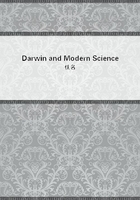
第231章
1888, page 255.) found that cross-fertilisation gave a beneficial result, although only in a slight degree. If the favourable effects of sexual reproduction, according to Darwin's view, are correlated with change of environment, it is quite possible that this is of less importance in plants which die after ripening their seeds ("hapaxanthic") and which in any case constantly change their situation. Objections which are based on the proof of the prevalence of self-fertilisation are not, therefore, pertinent. At first sight another point of view, which has been more recently urged, appears to have more weight.
W. Burck (Burck, "Darwin's Kreuzeungsgesetz...", "Biol. Centralbl". XXVIII.
1908, page 177.) has expressed the opinion that the beneficial results of cross-fertilisation demonstrated by Darwin concern only hybrid plants.
These alone become weaker by self-pollination; while pure species derive no advantage from crossing and no disadvantage from self-fertilisation. It is certain that some of the plants used by Darwin were of hybrid origin. (It is questionable if this was always the case.) This is evident from his statements, which are models of clearness and precision; he says that his Ipomoea plants "were probably the offspring of a cross." ("Cross and Self fertilisation" (1st edition), page 55.) The fixed forms of this plant, such as Hero, which was produced by self-fertilisation, and a form of Mimulus with white flowers spotted with red probably resulted from splitting of the hybrids. It is true that the phenomena observed in self-pollination, e.g. in Ipomoea, agree with those which are often noticed in hybrids; Darwin himself drew attention to this.
Let us next call to mind some of the peculiarities connected with hybridisation. We know that hybrids are often characterized by their large size, rapidity of growth, earlier production of flowers, wealth of flower-production and a longer life; hybrids, if crossed with one of the two parent forms, are usually more fertile than when they are crossed together or with another hybrid. But the characters which hybrids exhibit on self-fertilisation are rather variable. The following instance may be quoted from Gartner: "There are many hybrids which retain the self-fertility of the first generation during the second and later generations, but very often in a less degree; a considerable number, however, become sterile."But the hybrid varieties may be more fertile in the second generation than in the first, and in some hybrids the fertility with their own pollen increases in the second, third, and following generations. (K.F. Gartner, "Versuche uber die Bastarderzeugung", Stuttgart, 1849, page 149.) As yet it is impossible to lay down rules of general application for the self-fertility of hybrids. That the beneficial influence of crossing with a fresh stock rests on the same ground--a union of sexual cells possessing somewhat different characters--as the fact that many hybrids are distinguished by greater luxuriance, wealth of flowers, etc. corresponds entirely with Darwin's conclusions. It seems to me to follow clearly from his investigations that there is no essential difference between cross-fertilisation and hybridisation. The heterostyled plants are normally dependent on a process corresponding to hybridisation. The view that specifically distinct species could at best produce sterile hybrids was always opposed by Darwin. But if the good results of crossing were EXCLUSIVELY dependent on the fact that we are concerned with hybrids, there must then be a demonstration of two distinct things. First, that crossing with a fresh stock belonging to the same systematic entity or to the same hybrid, but cultivated for a considerable time under different conditions, shows no superiority over self-fertilisation, and that in pure species crossing gives no better results than self-pollination. If this were the case, we should be better able to understand why in one plant crossing is advantageous while in others, such as Darwin's Hero and the forms of Mimulus and Nicotiana no advantage is gained; these would then be pure species. But such a proof has not been supplied; the inference drawn from cleistogamous and cleistopetalous plants is not supported by evidence, and the experiments on geitonogamy and on the advantage of cross-fertilisation in species which are usually self-fertilised are opposed to this view.
There are still but few researches on this point; Darwin found that in Ononis minutissima, which produces cleistogamous as well as self-fertile chasmogamous flowers, the crossed and self-fertilised capsules produced seed in the proportion of 100:65 and that the average bore the proportion 100:86. Facts previously mentioned are also applicable to this case.
Further, it is certain that the self-sterility exhibited by many plants has nothing to do with hybridisation. Between self-sterility and reduced fertility as the result of self-fertilisation there is probably no fundamental difference.
It is certain that so difficult a problem as that of the significance of sexual reproduction requires much more investigation. Darwin was anything but dogmatic and always ready to alter an opinion when it was not based on definite proof: he wrote, "But the veil of secrecy is as yet far from lifted; nor will it be, until we can say why it is beneficial that the sexual elements should be differentiated to a certain extent, and why, if the differentiation be carried still further, injury follows." He has also shown us the way along which to follow up this problem; it is that of carefully planned and exact experimental research. It may be that eventually many things will be viewed in a different light, but Darwin's investigations will always form the foundation of Floral Biology on which the future may continue to build.